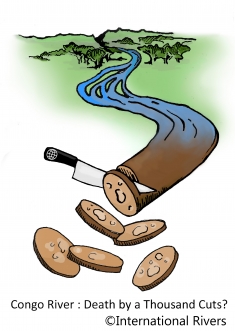A Time-Out on the World Bank’s Biggest Dam Project
Under mounting pressure from local and international NGOs, the World Bank has postponed a decision on the Inga 3 Project which it was supposed to take on February 11. The time-out is only the latest chapter in the twisted history of the controversial project on the Congo River. It offers the chance for a new start that better addresses the country’s needs.
The Inga 3 Dam in the Democratic Republic of Congo is the first phase of the Grand Inga complex, the largest hydropower scheme ever undertaken on the planet. With a price tag of US$12 billion and a planned capacity of 4,800 megawatts, Inga 3 alone would be the largest hydropower project the World Bank has ever funded. The dam would generate electricity for mining companies in the DRC and the South African market, and would bypass the more than 90% of the country’s population who don’t have access to electricity.
The Inga 3 Dam has exercised potential investors for more than three decades. Since the civil war in the DRC officially ended in 2003, the project was at one time or the other promoted by the World Energy Council, Southern Africa’s WestCor consortium, the global mining giant BHP Billiton, and (currently) the South African government. Like the Grand Inga scheme as a whole, Inga 3 has absorbed the DRC government and kept consulting companies busy for decades, but has not produced a single kilowatt hour of power during this period.
The World Bank is the latest institution to succumb to the Inga fever. The Bank started rehabilitating the Inga 1 and 2 dams, which were built on the Congo River in the 1970s and early 1980s, and their transmission lines in 2003. Even this worthwhile effort has turned into a quagmire. The cost has tripled to $1.2 billion, and the rehabilitation is nowhere near completion.
As part of its renewed focus on large dams, the World Bank embraced Inga 3 in May 2013. “People have been looking at the Inga Dam for as long as I have been in the development business,” the Bank’s Vice-President Rachel Kyte remarked. “The question is: Did the stars align? Did you have a government in place? Did people want to do it? Are there investors interested? Do you have the ability to do the technical work? The stars are aligned now. Let’s go.”
As a first step, the World Bank plans to fund social and environmental studies and make the Inga 3 Dam attractive for private investors with a technical assistance grant of $73 million. Under the Bank’s new strategy, the project is supposed to directly contribute to poverty reduction. The Bank management also promised to "apply the lessons of experience – as well as the Bank Group's own strict safeguards and guidelines – to ensure maximum sustainability " when developing the project. Yet Inga 3 fails on both accounts.
In a letter to the Bank’s board of directors, 12 NGOs from the DRC expressed concern that “most of the benefits from the proposed hydropower scheme will be enjoyed by urban, industrial and mining consumers, mainly in foreign countries, with little if any benefits accruing to the majority of Congolese.” The letter requested that “the energy needs of the DRC population are prioritized in a comprehensive needs assessment,” and that at least 50% of Inga 3’s power should be for the country’s population if the project were to go ahead.
In a briefing paper, International Rivers also documented that the Environmental Impact Assessment that the proposed World Bank grant would fund falls short of good international practice and the Bank’s own guidelines. Most importantly, the Bank does not intend to assess the cumulative impacts of the 11 dams and six hydropower projects that are planned under the Grand Inga scheme. Such environmental short-cuts not only violate the Bank’s own guidelines, they also demonstrate that the institution is not prepared to learn the lesson of past mistakes in the first major test case of its new hydropower strategy.
There is still time for the World Bank to avoid another development quagmire on the Congo River. The Power 4 People campaign, which International Rivers coordinates, promotes a shift of funding from large dams and fossil fuel plants to clean local energy solutions for poor communities. Such solutions would be more appropriate for poor countries with weak institutions such as the DRC than multi-billion dollar dams. The World Bank should not try to gain board approval for the Inga 3 Dam with some cosmetic changes. It should rather support a process in which the DRC government and civil society can comprehensively assess the energy solutions that best meet the needs of the country’s population.
Peter Bosshard is the Policy Director of International Rivers.
PS: Since the publication of this blog post, the Inga 3 Project has unfortunately gone from bad to worse. Read the latest update on the project here.





